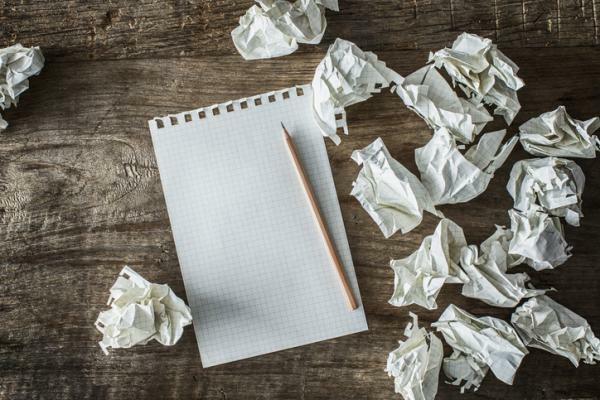
Dysgraphia is a functional neurological disorder that affects writing, specifically tracing or writing. Often, people with this disorder show difficulties in controlling the writing, since the control of this is a motor neuro-perceptual act that is affected in the dysgraphia.
Do your children suffer from dysgraphia? Do you dedicate yourself to teaching and do you have students with dysgraphia or suspicions that they may suffer from it? In addition, it is common for you to wonder how dysgraphia and general difficulties in writing can be differentiated according to the age of the person. In this case, or if you are interested in knowing and learning about the characteristics of dysgraphia, you can continue reading this article from Psychology-Online: Dysgraphia: definition, types, causes, treatment and examples.
Index
- Definition of dysgraphia
- Types of dysgraphia
- Causes of dysgraphia
- Treatment of dysgraphia
- Examples of dysgraphia
Definition of dysgraphia.
Dysgraphia is a disorder affecting the development and acquisition of writing skills of people, causing, above all, difficulties in free writing, in dictations and in copying an already written text.
In addition, dysgraphia must be differentiated from some cases, such as having poor handwriting, general difficulties typical of the age at which the learning process of writing occurs, dyslexia. Thus, dysgraphia is distinguished from these cases since people with this disorder have difficulties to automatically remember and master the motor movements required to write letters or numbers and form words. Therefore, dysgraphia affects writing and spelling ability, both in writing whole words and texts and isolated letters.
Characteristics of writing in dysgraphia
People with dysgraphia tend to share a number of characteristics in their writing. The characteristics of writing in dysgraphia are:
- Difficult to understand handwriting.
- Mirror writing: letters written as if they were the reflection of a mirror, that is, the other way around.
- Wrong or irregular spaces of letters and words: words together or syllables separated.
- Bad presentation: dirty and with marks of having erased words to write them again.
- Irregular font in both shape and size.
- Uppercase and lowercase letters used incorrectly.
- Poor body posture and the wrong way to hold the pencil when writing.
- They write slowly and clumsily, with errors.
- Elimination or omission of letters.
- Inverted letters.
- Letter confusion: for example, change an "a" to an "e".
- Inclination of the letters.
- Line slant, resulting in crooked text.
- Thick line and pressing hard or very soft, almost without leaving a trace of what is written.
Types of dysgraphia.
When we talk about the types of dysgraphia, we must differentiate two large classifications that, each of them includes different types of dysgraphia:
Acquired dysgraphia
Acquired dysgraphia consists of difficulties in writing due to consequence of a brain injury in people who already knew how to writeFor example, people who have suffered a trauma to a certain area of the head. In acquired dysgraphia, we can differentiate between central dysgraphia and peripheral dysgraphia:
1. Central acquired dysgraphia: this type of dysgraphia affects the linguistic aspects involved in the writing of words. Within central acquired dysgraphia we find three different types:
- Phonological acquired dysgraphia: this type of dysgraphia occurs when the phonological path is affected, in this path it is not recognize words as a whole, but rather small units such as syllables and the letters. This dysgraphia gives rise to difficulties in understanding the rules of grapheme-phoneme conversion, that is, in relating the sound and pronunciation of words to their way of writing them, therefore, people who suffer from this dysgraphia often make mistakes when they write unknown words, which are not part of their writing everyday. For example, the letter "g" when pronounced alone has a different intonation than when it is joined to the word "cat."
- Superficial acquired dysgraphia: this type of dysgraphia occurs when the visual path is affected, a path that allows us to recognize words, but does not allow words to be decoded without understanding them or without knowing them beforehand. For this reason, people tend to write slowly and even when spelling words, they have spelling errors, visual memory problems, difficulties in writing difficult and unfamiliar or unusual words in your day to day, among others.
- Deep acquired dysgraphia: this type of dysgraphia occurs when the two previous routes (visual and phonological) are affected. This is characterized because semantic errors are made, for example, they substitute football for basketball, giving rise to a substitution of words that are part of the same semantic field, in this case sports. In addition, there are difficulties in writing a word dictated by another person, even if its meaning is known.
2. Peripheral acquired dysgraphia: In this case, people who suffer from this type of dysgraphia show difficulties in remembering the movements required to be able to draw a letter or write words and phrases.
Evolutionary dysgraphia
Evolutionary dysgraphia occurs in people who are in the process of learning to write since they had never learned to write before, it is usually about children up to seven years or, in exceptional cases, in illiterate people. Within evolutionary dysgraphia, we can differentiate three different types of dysgraphia:
- Phonological evolutionary dysgraphia: people who suffer from a phonological or superficial developmental dysgraphia tend to present the same difficulties as people who suffer from an acquired phonological or acquired dysgraphia superficial, although they differ since in the evolutionary ones it is about the natural learning process and in the acquired ones they are about people who before suffering a brain injury already knew to write.
- Superficial evolutionary dysgraphia.
- Mixed evolutionary dysgraphia: On the other hand, unlike deep acquired dysgraphia, there are no semantic errors in mixed developmental dysgraphia. Mixed dysgraphia is the most frequent within the evolutionary dysgraphia, since the difficulties that occur in one of the routes (visual or phonological), as a consequence, it hinders the development of the other route.
Causes of dysgraphia.
As we have mentioned previously, there are two possible causes of dysgraphia (acquired or evolutionary) and there are several causes that can originate either of the two:
- Lateralization problems.
- Motor difficulties: difficulty in movement, both fingers and hands, and difficulties in balance and general organization of the body.
- Personality factors: causes related to the personality and the characteristics of the person with dysgraphia, for example, whether the person is fast or slow.
- Pedagogical causes: there are causes related to the education received in relation to writing, such as having been subjected to a rigid teaching and not adapted to the individual differences of each student, submitting to demands set by the teacher, family and social pressure among peers such as writing well and quickly, among others.
- Difficulties in visual-perceptual ability: problems identifying what is seen. For example, difficulties in interpreting what a ball is when the person has it in front of him or sees it in a photograph.
- Difficulty retaining a word in memory and difficulties in the ability to retrieve a word that we are supposed to retain in memory.
- Visual-motor coordination: difficulties in the ability to coordinate body movement with vision.

Treatment of dysgraphia.
It is of great importance to diagnose and treat dysgraphia as soon as possible, due to its negative effect, especially in the academic field. But before starting to treat it, you must carefully observe what are the difficulties that the person presents, to be able to make an approach specific and focused on the specific characteristics of each patient, that is, to be able to carry out an adapted treatment focused on the person.
To adequately treat dysgraphia, intervene in different areas:
- Gross motor skills (global movement capacity): teach the patient what is the correct posture to write, with the aim of being able to correct their bad posture, for example, how they should sit, the distance between the head and the paper, the position of the paper, how to hold the pencil, among others.
- Fine motor skills (more detailed movements, requiring more control, usually movements with the fingers): this type of movements should be treated as they affect the dependence of the hand and fingers, with the aim of getting the patient acquire precision and coordination when writing. Some examples of exercises to strengthen fine motor skills are cutting out papers in a certain way and reviewing lines.
- Perception: it is important to work on perception since the difficulties that patients show in relation to temporal, spatial, visual-perceptual and attentional perception, can cause errors or difficulties in the fluency, inclination and orientation of the writing.
- Viso-motor skills: the function of visual-motor skills is coordinate eye movement with body movement. In the event that this function is affected, especially when it comes to the movement of the hands and the fingers, makes it difficult for people to write and, therefore, work should be done to improve it coordination.
- Graph-motor skills: it is necessary to treat graph-motor skills in order to correct basic writing movements. To do this, it is recommended to perform exercises that stimulate the basic movements of the letters, such as writing a letter by joining points already marked, review letters or figures already written or drawn, follow borders that involve looping movements, between others.
- The graph-writing: to deal with the area of graph-writing, calligraphy exercises are usually used, to be able to improve all the letters that make up the alphabet.
- Writer improvement: in this case, it is intended improve writing fluency and spelling mistakes. It is recommended to perform exercises such as copying letters, joining syllables to form a word, joining a word with its corresponding drawing (for example, match the word “ball” with the drawing of a ball), between others.
- Relaxation: it is common for the patient to fatigue between activities that involve a lot of effort, therefore, it is recommended relax the wrist, fingers, etc. For this, these relaxation exercises for children.
Examples of dysgraphia.
Example of acquired dysgraphia
A girl has a motorcycle accident in which she hits her head, causing a traumatic brain injury and affecting precisely the area of the brain that is responsible for writing. He goes into a coma for a few months and when he wakes up his relatives realize that he is not writes in the same way as before, now presents much more difficulty than ever before shown. From the hospital, they consider that it is an acquired peripheral dysgraphia, since he has difficulties to remember the movement necessary to be able to trace the letters.
Evolutionary dysgraphia example
A five-year-old boy shows difficulties when it comes to writing. At first the parents did not attach much importance to it, but when they saw that the child, at six years old, continued to show the same difficulties, they were surprised. Then they spoke with the teacher, to see if the other classmates of her son also showed these difficulties. The teacher told them that her son was one of the few students who had the most difficulty writing and she asked their permission so that her son could be visited by the school psychologist, the parents they accepted. When the child met with the psychologist, she suggested different activities that involved writing, so that she could see his body position, her inclination, etc., so that she finally considered it to be an evolutionary dysgraphia phonological of her. It is important to know how to detect when it is necessary to go to the child psychologist.
This article is merely informative, in Psychology-Online we do not have the power to make a diagnosis or recommend a treatment. We invite you to go to a psychologist to treat your particular case.
If you want to read more articles similar to Dysgraphia: definition, types, causes, treatment and examples, we recommend that you enter our category of Clinical psychology.
Bibliography
- Andreu, L., Serra, J.M., Soler, O., and Tolchinsky, L. (2013). Disorders of learning of writing and mathematics. Open University of Catalonia.
- Calderán, I.M., and Zamorano, F. (1998). Difficulties in the acquisition of reading and writing and other learning.
- Criollo, D. (2012). Dysgraphia as a handwriting learning difficulty in basic general education schoolchildren. University of Cuenca.
- Puente, A.G. (2012). Learning disabilities and ICT: dyslexia, dysgraphia and dyscalculia. International University of La Rioja, Faculty of Education.
- Silva, C. (2011). Classification of dysgraphia.
Dysgraphia: definition, types, causes, treatment and examples


